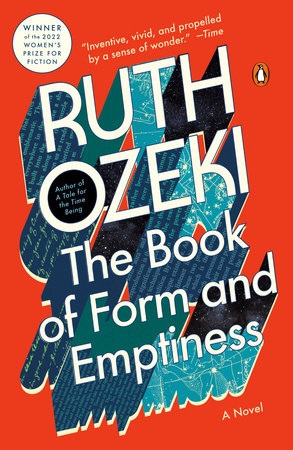
The Book of Form and Emptiness, Ruth Ozeki
Penguin, 2022
548 p.
ISBN: 978-0-399-56366-9
The Book Of Form and Emptiness by Ruth Ozeki is the winning novel of the Women’s Prize for Fiction 2022, one of the most prestigious literary awards in the United Kingdom. It is awarded annually to a female author of any nationality for the best original novel written in English and published in the United Kingdom during the previous year. These awards always catch my attention with their very interesting proposals.
This novel is no exception. Anabelle, Benny and Kenji form a very happy family (with some ups and downs but also a lot of love) until Kenji dies in an accident that is equally tragic and ridiculous. After that the lives of his wife and son go off the rails and every day seems to bring them more problems and more suffering.
The novel deals with very varied themes: the loss of a loved one, grief, mental health, social issues, the concept of living outside or on the margins of society, the love of books, philosophy, unhealthy consumerism, abuses… It seems like a lot for one book, but everything really fits together very well, everything has its logic.
It may be a book that is not for people who need very fast-paced action in a novel. It’s rather a slow read and perhaps with some pages that may feel somewhat repetitive. But without a doubt it is a book that gives a lot to talk about, with very complex and varied topics.
On October, 9th at Donostia Book Club we will talk about the problems presented in this novel in detail. If you also feel like analyzing it in depth, here are some of the questions raised by the Women’s Prize team:
- Ozeki examines the theme of hoarding in The Book of Form and
Emptiness. Do you think hoarding is more of a modern problem,
given our immersion in consumer culture in the past 50 years?
- What is Ozeki telling us about consumerism in this book?
- Ozeki talks about books as objects among Benny’s Book’s
discussion of the Made and Unmade. Are books objects like
hammers and tin cans, or are they different in some way? How?
- Are libraries places of self-discovery, of knowledge, of a huge web of
interconnected voices, of sanctuary – or all or none of these?
How does Ozeki centre the library as a place of importance?
- In the paediatric psych ward, Benny meets Alice/Athena, who is making
written ‘event scores’ and handing them out to her fellow patients.
The event score is a feature of the Fluxus art movement which aimed
to create live ‘happenings’ rather than fixed art pieces. Can art be
in-the-moment as opposed to just a static thing that hangs on a
gallery wall for a long time?
|

